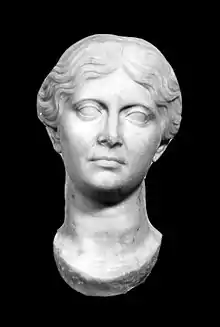Julia the Younger
Vipsania Julia Agrippina (19 BC – c. AD 29) nicknamed Julia Minor (Classical Latin: IVLIA•MINOR)[1] and called Julia the Younger by modern historians, was a Roman noblewoman of the Julio-Claudian dynasty. She was emperor Augustus' first granddaughter, being the first daughter and second child of Julia the Elder and her husband Marcus Vipsanius Agrippa. Along with her siblings Julia was raised and educated by her maternal grandfather Augustus and her maternal step-grandmother Livia Drusilla. Just like her siblings she played an important role in the dynastic plans of Augustus, but much like her mother she was disgraced due to infidelity later on in her life.
| Julia the Younger | |
|---|---|
 Bust presumed to be Julia | |
| Born | 19 BC |
| Died | 29 AD Tremirus |
| Spouse | Lucius Aemilius Paullus |
| Issue | Aemilia Lepida Marcus Aemilius Lepidus (possible) |
| House | Julio-Claudian dynasty |
| Father | Marcus Vipsanius Agrippa |
| Mother | Julia the Elder |
Life
About 5 BC or 6 BC, Augustus arranged her to marry Lucius Aemilius Paullus.[2] Paullus had a family relation to her as her first half-cousin, as both had Scribonia as grandmother: Julia's mother was a daughter of Scribonia by Augustus; Paullus' mother, Cornelia, was a daughter of Scribonia resulting from her earlier marriage to Publius Cornelius Scipio Salvito.
Paullus and Julia had a daughter, Aemilia Lepida and possibly a son, Marcus Aemilius Lepidus (although the latter may also have been the son to Marcus Aemilius Lepidus (consul 6). According to Suetonius, she built a large pretentious country house. Augustus disliked large overdone houses and had it demolished.[3]

In 8, according to ancient historians, Julia was exiled for having an affair with Decimus Junius Silanus, a Roman Senator. She was sent to Tremirus, a small Italian island, where she gave birth to a child. Augustus rejected the infant and ordered it to be exposed,[4] or left on a mountainside to die. Silanus went into voluntary exile, but returned under Tiberius' reign.[5]
Sometime between 1 and 14, her husband Paullus was executed as a conspirator in a revolt.[6] Modern historians theorize that Julia's exile was not actually for adultery but for involvement in Paullus' revolt.[7] Livia plotted against her stepdaughter's family and ruined them, according to some. This led to open compassion for the fallen family. In 29 AD, Julia died on the same island where she had been sent in exile twenty years earlier.[8] Due to the adultery that Julia committed, Augustus stated in his will that she would never be buried in Rome.[9] She was survived by a daughter, possibly a son, and by several grandchildren.
Unusual naming
Julia the Younger was not a member of the Julian gens by birth: being the daughter of Marcus Vipsanius Agrippa made her a Vipsania Agrippina by birth, although there are no contemporary sources that show that that name was ever used for her. She came to belong to the household of the Julio-Claudian dynasty as she was raised and instructed by her maternal grandfather Augustus.[10] Further, Augustus adopted Tiberius as his son (and heir), while Tiberius was remarried to Julia the Elder. Augustus became something of a paternal grandfather to Julia the Elder's children, too, including Julia the Younger. A formal adoption "in the family of the Caesars" among the offspring of Agrippa and Julia the Elder is however only recorded regarding Vipsania Julia's brothers Gaius Vipsanius Agrippa—hence Gaius Julius Caesar—and Lucius Vipsanius Agrippa—hence Lucius Julius Caesar.[11] Her younger sister Agrippina the Elder and youngest full brother, Marcus Vipsanius Agrippa Postumus, were named after their natural father only until Agrippa Postumus was adopted by Augustus as Marcus Julius Caesar Agrippa Postumus. Likewise, her eldest half-sisters, Vipsania Agrippina, Vipsania Attica, Vipsania Marcella and Vipsania Marcellina, were named after their father. Her younger half-brother, unnamed in contemporary sources, was later sometimes dubbed "Tiberillus," after his father Tiberius, and died young.
Ancestry
| Ancestors of Julia the Younger | |||||||||||||||||||||||||||||||||||||||||||||||||||||||||||||||||||||||||||||||||||||||||||||||||||||||||||||||||||||||||||||||||||||||||||||||||||||||||||||||||||||||||||||||||||||||||||||||||||||||||||||||||||||||||||||||||||||||||||||||||||||||||||||||||||||||||||||||||||||||||||||||||||||||||||||||||||||||||||||||||||||||||||||||||||||||||||||||||||||||||||||||||||||||||||||||||||||||||||||||||||||||||||||||||||||||||||||||||||||||||||||||||||||||||||||||||||||||||||||||||||||||||||||||||||||||||||||||||||||||||||||
|---|---|---|---|---|---|---|---|---|---|---|---|---|---|---|---|---|---|---|---|---|---|---|---|---|---|---|---|---|---|---|---|---|---|---|---|---|---|---|---|---|---|---|---|---|---|---|---|---|---|---|---|---|---|---|---|---|---|---|---|---|---|---|---|---|---|---|---|---|---|---|---|---|---|---|---|---|---|---|---|---|---|---|---|---|---|---|---|---|---|---|---|---|---|---|---|---|---|---|---|---|---|---|---|---|---|---|---|---|---|---|---|---|---|---|---|---|---|---|---|---|---|---|---|---|---|---|---|---|---|---|---|---|---|---|---|---|---|---|---|---|---|---|---|---|---|---|---|---|---|---|---|---|---|---|---|---|---|---|---|---|---|---|---|---|---|---|---|---|---|---|---|---|---|---|---|---|---|---|---|---|---|---|---|---|---|---|---|---|---|---|---|---|---|---|---|---|---|---|---|---|---|---|---|---|---|---|---|---|---|---|---|---|---|---|---|---|---|---|---|---|---|---|---|---|---|---|---|---|---|---|---|---|---|---|---|---|---|---|---|---|---|---|---|---|---|---|---|---|---|---|---|---|---|---|---|---|---|---|---|---|---|---|---|---|---|---|---|---|---|---|---|---|---|---|---|---|---|---|---|---|---|---|---|---|---|---|---|---|---|---|---|---|---|---|---|---|---|---|---|---|---|---|---|---|---|---|---|---|---|---|---|---|---|---|---|---|---|---|---|---|---|---|---|---|---|---|---|---|---|---|---|---|---|---|---|---|---|---|---|---|---|---|---|---|---|---|---|---|---|---|---|---|---|---|---|---|---|---|---|---|---|---|---|---|---|---|---|---|---|---|---|---|---|---|---|---|---|---|---|---|---|---|---|---|---|---|---|---|---|---|---|---|---|---|---|---|---|---|---|---|---|---|---|---|---|---|---|---|---|---|---|---|---|---|---|---|---|---|---|---|---|---|---|---|---|---|---|---|---|---|---|---|---|---|---|---|---|---|---|---|---|---|---|---|---|---|---|---|---|---|---|---|---|---|---|---|---|---|---|---|---|---|---|---|---|---|---|---|---|---|---|---|---|---|---|---|---|---|---|---|---|---|---|---|---|---|---|---|---|---|---|---|---|---|---|---|---|---|---|---|---|---|---|---|---|---|---|---|---|---|---|---|---|---|---|---|---|---|---|---|---|---|---|---|---|
| |||||||||||||||||||||||||||||||||||||||||||||||||||||||||||||||||||||||||||||||||||||||||||||||||||||||||||||||||||||||||||||||||||||||||||||||||||||||||||||||||||||||||||||||||||||||||||||||||||||||||||||||||||||||||||||||||||||||||||||||||||||||||||||||||||||||||||||||||||||||||||||||||||||||||||||||||||||||||||||||||||||||||||||||||||||||||||||||||||||||||||||||||||||||||||||||||||||||||||||||||||||||||||||||||||||||||||||||||||||||||||||||||||||||||||||||||||||||||||||||||||||||||||||||||||||||||||||||||||||||||||||
See also
Notes
- E. Groag, A. Stein, L. Petersen – e.a. (edd.), Prosopographia Imperii Romani saeculi I, II et III (PIR), Berlin, 1933 – I 635
- Suetonius, The Twelve Caesars, "II. Augustus", LXIV
- Suetonius, The Twelve Caesars, "II. Augustus", LXXII
- Suetonius, The Twelve Caesars, "II. Augustus", LXV
- Tacitus, Ann. III, 24
- Suetonius, The Lives of Caesars, Life of Augustus 19
- Norwood, Frances, "The Riddle of Ovid's Relegatio" Classical Philology (1963) p. 154
- Tacitus, Ann. IV, 71
- Suetonius, The Twelve Caesars, "II. Augustus", CI
- Suetonius, The Twelve Caesars, "II. Augustus", LXIV—note that Augustus was member of the Julii Caesares gens through (posthumous) adoption by the (maternal) uncle of his mother Atia—that maternal uncle was of course Julius Caesar; Augustus was an Octavius by birth (hence his name Octavianus after his posthumous adoption had taken place).
- Tacitus, Ann. I, 3
External links
| Wikimedia Commons has media related to Vipsania Julia. |
- The Archeological museum of the University of Innsbruck displays a sculpted head that is presumably Vipsania Julia's: Inv. Nr. I/506 – Image at the university's website.